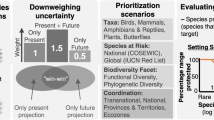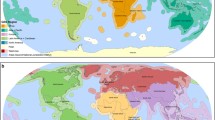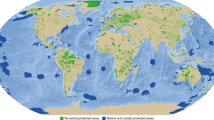Abstract
The Convention on Biodiversity (CBD) commits its signatories to the identification and monitoring of biodiversity. The European Union has implemented this commitment into its legislation. Despite the legal requirement resources are scarce, requiring a prioritization of conservation actions, including e.g. monitoring. Red lists are currently the most prominent tool for priority setting in applied conservation, despite the fact that they were not developed for that purpose. Therefore, it is hardly surprising that they do not always reflect actual conservation needs. As a response, the concept of national responsibility as a complementary tool was developed during the last two decades. The existing methods are country specific and mainly incomparable on an international scale. Here, we present a newly developed method, which is applicable to any taxonomic group, adjustable to different geographic scales, with little data requirements and clear categorizations. We apply the new method to over 1,000 species in several countries of different size and report on the applicability of our method and discuss problems that derive from the currently available data. Our method has several major advantages compared to currently available methods. It is applicable to any geographic range, allows automatization, given database availability, and is readily adjustable to future data improvements. It further has comparably low data demands by exploiting one of the most commonly available information on biodiversity, i.e. distribution maps. We believe that our method allows the allocation of the limited resources in nature conservation in the most sensible way, e.g. the sharing of monitoring duties, effectively selecting networks of protected areas, improving knowledge on biodiversity, and closing information gaps in many species groups.






Similar content being viewed by others
References
Beissinger SR, Reed JM, Wunderle JM Jr et al (2000) Report of the AOU conservation committee on the partners in flight species prioritization plan. Auk 117(2):549–561
Brooks TM, Mittermeier RA, da Fonseca GAB et al (2006) Global biodiversity conservation priorities. Science 313(5783):58–61
Brown JH (1984) On the relationship between abundance and distribution of species. Am Nat 124(2):255–279
Burfield I, van Bommel F, Gallo-Orsi U et al (2004) Birds in Europe: population estimates, trends and conservation status. BirdLife International, Cambridge, UK
Carter MF, Hunter WC, Pashley DN et al (2000) Setting conservation priorities for landbirds in the United States: the partners in flight approach. Auk 117(2):541–548
Coates DJ, Atkins KA (2001) Priority setting and the conservation of Western Australia’s diverse and highly endemic flora. Biol Conserv 97(2):251–263
Couturier A (1999) Conservation priorities for the birds of Southern Ontario. Technical appendices, and priority species lists 15. Bird studies Canada, Port Rowan, Ontario
Eaton MA, Gregory RD, Noble DG et al (2005) Regional IUCN red listing: the process as applied to birds in the United Kingdom. Conserv Biol 19(5):1557–1570
Fitzpatrick UNA, Murray TE, Paxton RJ et al (2007) Building on IUCN regional red lists to produce lists of species of conservation priority: a model with Irish bees. Conserv Biol 21(5):1324–1332
Fraser DJ, Bernatchez L (2001) Adaptive evolutionary conservation: towards a unified concept for defining conservation units. Mol Ecol 10(12):2741–2752
Freitag S, Jaarsveld ASV (1997) Relative occupancy, endemism, taxonomic distinctiveness and vulnerability: prioritizing regional conservation actions. Biodivers Conserv 6(2):211–232
Gärdenfors U (2000) Population viability analysis in the classification of threatened species: problems and potentials. Ecol Bull 48:181–190
Gärdenfors U (2001) Classifying threatened species at national versus global levels. Trends Ecol Evol 16(9):511–516
Gasc JP, Cabela A, Crnobrnja-Isailovic J et al (1997) Atlas of amphibians and reptiles in Europe. Societas Europaea Herpetologica and Muséum National d’Histoire Naturelle (IEGB/SPN), Paris, France
Griffiths HI, Krystufek B, Reed JM (2004) Balkan biodiversity: pattern and process in the European hotspot. Kluwer Academic, The Netherlands
Hanski I (1982) On patterns of temporal and spatial variation in animal populations. Annales Zoologici Fennici 19(1):21–37
Hanski I (1991) Single-species metapopulation dynamics: concepts, models and observation. In: Gilpin M, Hanski I (eds) Metapopulation dynamics. Academic Press, London, pp 17–38
Hanski I (1994) A practical model of metapopulation dynamics. J Anim Ecol 63:151–162
Hanski I (2001) Spatially realistic theory of metapopulation ecology. Naturwissenschaften 88:372–381
Hanski I, Gyllenberg M (1997) Uniting two general patterns in the distribution of species. Science 275(5298):397–400
Hanski I, Pöyry J, Pakkala T et al (1995) Multiple equilibria in metapopulation dynamics. Nature 377:618–621
Henle K, Davies KF, Kleyer M, Margules C, Settele J (2004) Predictors of species sensitivity to fragmentation. Biodiv Conserv 13:207–251
Hobohm C (2003) Characterization and ranking of biodiversity hotspots: centres of species richness and endemism. Biodivers Conserv 12(2):279–287
IUCN (1996) In: Baille JEM, Groombridge B (eds) IUCN Red List of threatened animals. IUCN, Gland, Switzerland
IUCN (2001) IUCN Red List Categories and Criteria: version 3.1. IUCN Species Survival Commission. IUCN, Gland, Switzerland and Cambridge, UK
Jalas J, Suominen J, Lampinen R et al (1999) Distribution of vascular plants in Europe. Atlas Florae Europaeae 12. The Committee for Mapping the Flora of Europe and Societas Biologica Fennica Vanamo, Helsinki, Finland
Keller V, Bollmann K (2001) For which bird species does Switzerland have a particular responsibility? Für welche Vogelarten trägt die Schweiz eine besondere Verantwortung? Ornithologische Beobachter 98(4):323–340
Keller V, Bollmann K (2004) From red lists to species of conservation concern. Conserv Biol 18(6):1636–1644
Mace GM, Purvis A (2008) Evolutionary biology and practical conservation: bridging a widening gap. Mol Ecol 17:9–19
Maurer BA, Taper ML (2002) Connecting geographical distributions with population processes. Ecol Lett 5(2):223–231
McIntyre NE, Wiens JA (1999) Interactions between landscape structure and animal behavior: the roles of heterogeneously distributed resources and food deprivation on movement patterns. Landscape Ecol 14(5):437–447
Mehlman DW, Rosenberg KV, Wells JV et al (2004) A comparison of North American avian conservation priority ranking systems. Biol Conserv 120(3):383–390
Metzger MJ, Bunce RGH, Jongman RHG et al (2005) A climatic stratification of the environment of Europe. Glob Ecol Biogeogr 14(6):549–563
Miller RM, Rodriguez JP, Aniskowicz-Fowler T et al (2007) National threatened species listing based on IUCN criteria and regional guidelines: current status and future perspectives. Conserv Biol 21(3):684–696
Moritz C (1994) Defining “evolutionary significant units” for conservation. Trends Ecol Evol 9:373–375
Rabinowitz A (1981) Seven forms of rarity. The biological aspects of rare plant conservation. Wiley, Chichester, UK, pp 205–235
Rodriguez JP (2002) Range contraction in declining North American bird populations. Ecol Appl 12(1):238–248
Roekaerts M (2002) The biogeographical regions map of Europe. Basic principles of its creation and overview of its development. European Environmental Agency, Copenhagen (http://dataservice.eea.europa.eu/download.asp?id=5234andfiletype=.pdf)
Sagarin RD, Gaines SD, Gaylord B (2006) Moving beyond assumptions to understand abundance distributions across the ranges of species. Trends Ecol Evol 21(9):524–530
Schmeller DS, Gruber B, Budrys E et al (2008) National responsibilities in European species conservation: a methodological review. Conserv Biol 22(3):593–601
Schnittler M (2004) Verantwortlichkeitsanalyse: Wie lassen sich Theorie und Naturschutzpraxis vereinen. Naturschutz und Biologische Vielfalt 8:39–52
Schnittler M, Günther KF (1999) Central European vascular plants requiring priority conservation measures: an analysis from national Red Lists and distribution maps. Biodivers Conserv 8(7):891–925
Schnittler M, Ludwig G, Pretscher P et al (1994) Konzeption der Roten Listen der in Deutschland gefährdeten Tier- und Pflanzenarten—unter Berücksichtigung der neuen internationalen Kategorien. Natur und Landschaft 69(10):451–459
The Nature Conservancy (1988) The Natural heritage program operations manual, Arlington, Virginia, USA
Turin H, Penev L (2003) The genus Carabus in Europe. A synthesis. Fauna Europaea Evertebrata 2. Pensoft Publishers, Sofia, Bulgaria
Wiens JA, Schooley RL, Weeks RD (1997) Patchy landscapes and animal movements: do beetles percolate? Oikos 78(2):257–264
Acknowledgements
This article is a result of the EU-project EuMon (http://eumon.ckff.si), financed by the EU Commission (contract number 6463). We would like to thank other EuMon-colleagues for fruitful discussions.
Author information
Authors and Affiliations
Corresponding author
Rights and permissions
About this article
Cite this article
Schmeller, D.S., Gruber, B., Bauch, B. et al. Determination of national conservation responsibilities for species conservation in regions with multiple political jurisdictions. Biodivers Conserv 17, 3607–3622 (2008). https://doi.org/10.1007/s10531-008-9439-8
Received:
Accepted:
Published:
Issue Date:
DOI: https://doi.org/10.1007/s10531-008-9439-8




